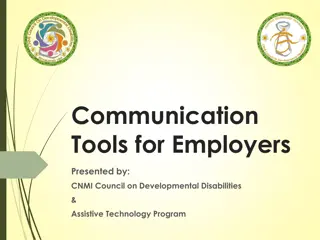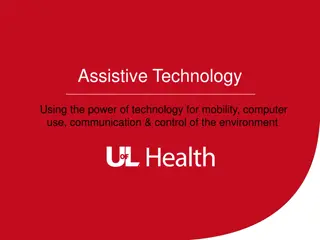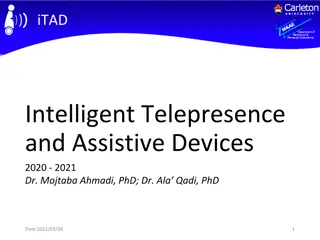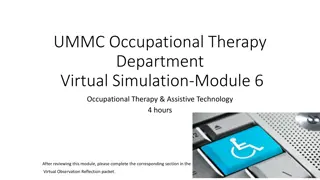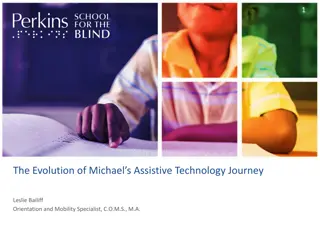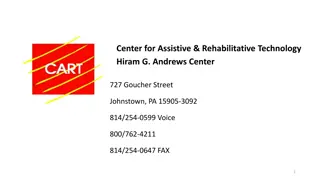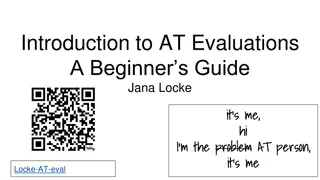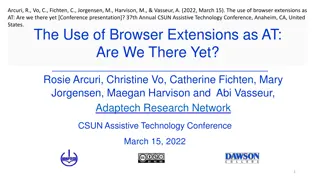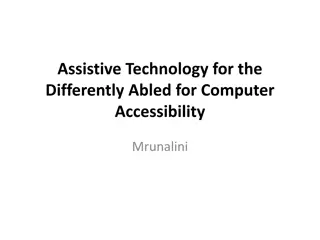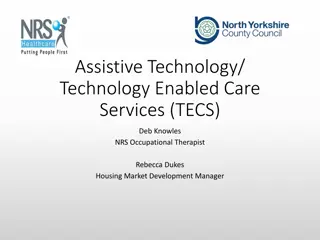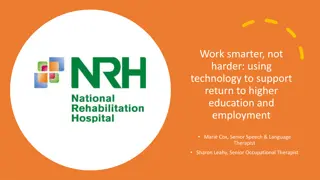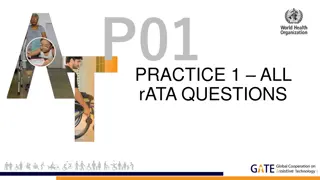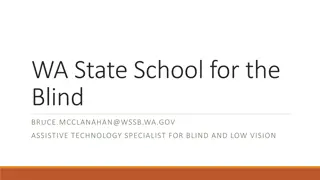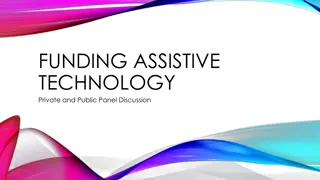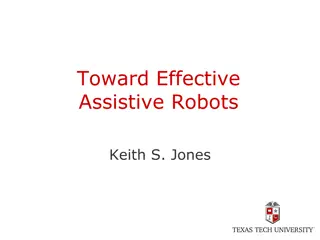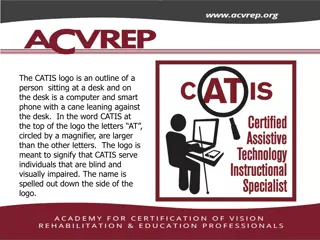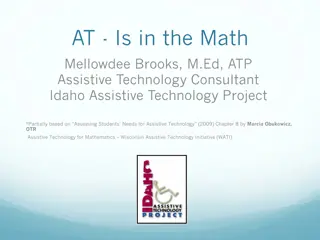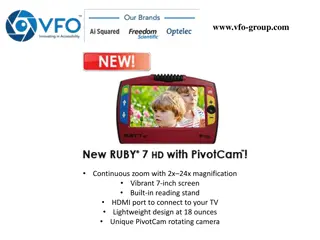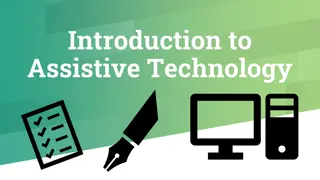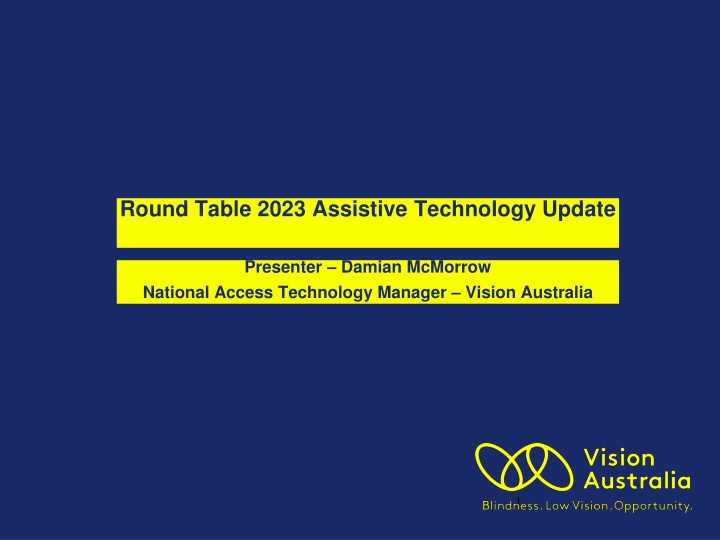
Advancements in Braille Technology for Accessibility & Inclusion
Explore the latest advancements in Braille technology with a focus on tactile tablet devices, wearable tech integrating AI recognition, and the game-changing potential of these devices. Learn about innovative devices like the Monarch, a collaborative project between Humanware and APH, offering new possibilities for Braille users. Discover how the EBRF file format is enhancing accessibility for displaying graphics and text elements. Stay updated on the evolution of assistive technology for improved daily living, work, and education opportunities.
Download Presentation

Please find below an Image/Link to download the presentation.
The content on the website is provided AS IS for your information and personal use only. It may not be sold, licensed, or shared on other websites without obtaining consent from the author. If you encounter any issues during the download, it is possible that the publisher has removed the file from their server.
You are allowed to download the files provided on this website for personal or commercial use, subject to the condition that they are used lawfully. All files are the property of their respective owners.
The content on the website is provided AS IS for your information and personal use only. It may not be sold, licensed, or shared on other websites without obtaining consent from the author.
E N D
Presentation Transcript
Round Table 2023 Assistive Technology Update Presenter Damian McMorrow National Access Technology Manager Vision Australia 1
About Me. I am blind from birth, and began using Assistive Technology around 40 years ago; I have 16 years experience working in the AT field, and have spent almost all of my working life in either the AT or IT field; I have worked with people of all ages, in homes, communities, schools and workplaces; I am a very strong advocate for Braille, and am extremely interested in the ways in which technology, and access to information can be used to enhance our daily lives, as well as our work and education opportunities. 2 Page
What we will cover today Advancements in Braille technology, particularly tactile tablet devices; Wearable technology, and how this technology is used in conjunction with AI to recognise objects, people, and text; Integration of technologies such as Chat GPT, into wearable devices; How these devices will be game changers over the next couple of years. 3 Page
Advances in Braille devices In the last twelve months, we have seen a number of prototype Braille tablet devices, either entering the market or promising to do so in the next few months. These devices are a change from the previous single-line displays in that they can produce either multiple lines of text, or a line of text as well as graphics. Devices of this type include the Dot Pad from Korean company Dot Inc, and the Monarch, which is being developed as a collaboration between Humanware and American Printing House for the Blind (APH) 4 Page
The Monarch The Monarch is a collaboration between Humanware and APH. The device is approximately the size of a 15 laptop, and can produce 10 lines of Braille. The key difference between this, and most other current Braille technology is that the pins are not placed in the traditional six dot cell pattern, which means that lines can effectively be drawn in any direction making it possible to produce graphs and diagrams. 5 Page
The Monarch Continued Humanware, APH, the DAISY Consortium, and others have combined to develop a new file format called EBRF, which will enable graphics, and other elements commonly found in textbooks to be displayed on the Monarch. The advantage of this approach is that conversion of material to EBRF format should be faster and easier than the current process of manual conversion and embossing, which could provide earlier access to material. It may also be possible to display images or shapes drawn in real time, which will be helpful for early learning of shapes and simple visual concepts. 6 Page
The Monarch Continued The challenges with this approach are that some people, particularly those who have never had vision, sometimes struggle with interpreting diagrams, and pictures such as those of animals and buildings. The anticipated high cost of this device at time of launch is likely to place it out-of-reach of many consumers, so it may fall to education authorities to fund this type of device. Despite this, the potential this device is likely to offer, particularly in the education space, and the way this changes Braille display technology are extremely exciting. 7 Page
The Dot Pad The Dot Pad, from Korean company Dot Inc, is a little different in that it has two distinct tactile surfaces; There is a 20 cell Braille display for text, as well as a 10X30 cell area for displaying graphics. The device is designed primarily to connect to an iPad with Voiceover running. 8 Page
The Dot Pad continued The text spoken by Voiceover is displayed on the text section of the Dot Pad, while shapes, such as the visual icons on the screen are displayed on the graphics section; Shapes can also be drawn and instantly displayed using the Canvas app, and visual content from maps, and other applications can also be shown. The Dot Pad, is quite a bit cheaper than the Monarch, however, since it does not currently support formats like EBRF, its main benefit will be in the ability to quickly produce tactile graphics and drawings. It also appears to currently only support IOS, though this may change in the future. 9 Page
Wearable devices Over the last couple of years, we have seen a number of wearable devices, including the OrCam, Envision Glasses, IrisVision, ARX Vision and the Vision Buddy. Some of these devices provide magnification while others focus on OCR, person, and object detection. For the purposes of this presentation I want to focus on those devices that provide text, person and object detection, because, while these devices aren t new anymore, their capability is changing. In particular, I d like to focus on both Envision and ARXVision. 10 Page
ARXVision ARXVision is a bone conduction headset with a camera module fitted to the righthand side. This module contains two cameras and 3 buttons, and the device connects via USB-C to an Android phone. 11 Page
ARXVision continued While this product does have it s limitations, specifically the wired connection, and the fact that it supports Android only at this stage, it is actively under development and is improving rapidly. One unique feature it has is the ability to combine scene description with text and person recognition, so that the wearer doesn t need to switch modes in order to receive a running commentary of what is in the visual environment. 12 Page
Envision Glasses The Envision Glasses have been available for a couple of years, but in that time, there have been a number of new features added. The device is based on the Google Glass platform, and looks like a pair of glasses, with a slightly larger righthand arm, which contains the camera, battery, and other components. 13 Page
Envision glasses continued The device connects to the internet over Wi-Fi and can perform text recognition, face recognition, scene description, (though not all at once) and also has the ability to place calls to the AIRA service as well as to people using the Envision Ally app. Like ARX, this device can be a great way to get information on the fly about your environment, using artificial intelligence, and other recognition technologies. 14 Page
IOS Devices We are also starting to see some of this capability integrated into Apple IOS devices. For example the camera app on iPhone Pro now supports door detection, and the ability to read door signage. The Seeing AI app now also includes some indoor navigation features, which use intelligent object recognition to plot and follow indoor routes, and detect and place beacons on specific objects. 15 Page
Chat GPT and Wearable Devices One of the most exciting, and at the same time, frightening developments in the tech world in recent months is that of Chat GPT from Open AI. In its standard form, you can access this service through a browser, and ask it all sorts of questions about people, technology, history, and a range of other topics. It can even be used to write stories and essays, much to the consternation of many educators and education institutions. This technology is now also being included in wearable devices such as Envision and ARX. This means that, after scanning a menu for example, you could ask what is the cheapest thing on the menu, how much is the toasted sandwich, or what are the vegetarian options. 16 Page
Chat GPT and Wearable Devices continued Similarly, on scanning a bill, you could, using voice commands, ask for the total, or when it needs to be paid. This is a significant development, because, in a world where we are all time poor, and need quick and efficient access to information, we no longer need to listen to an entire document, and then scroll back and forth to get the specific detail we want, we can use AI to extract this for us. The capability of this technology is growing and improving over time, and we are likely to see it being integrated into many apps and devices in the coming years. 17 Page
Other applications for Chat GPT and similar technologies. This technology can also be used to describe photos and scenes, in much more detail than we ve had access to previously. This is because we can ask specific questions about the picture, in order to get the specific information we want. On getting a description of a room, for example, I could then ask, tell me about the furniture or describe the posters on the wall. 18 Page
Conclusion If we look at all of the technologies I ve talked about today, it is clear that they all have the potential to give us greater access to information. From tactile graphics and textbooks through to on-the-fly information about the visual environment, this potentially means greater opportunity for work and study, and greater mobility through increased awareness of our environment and surroundings. While some of this builds on technology we already have, some of it is very new, and the range of possibilities it offers is still being explored, however, anything which gives us greater access and greater opportunities is clearly an exciting development. 19 Page
Contact Details. Damian (Damo) McMorrow National Access Technology Manager Vision Australia Email: damian.mcmorrow@visionaustralia.org Phone: 0429 937 459. 20 Page


